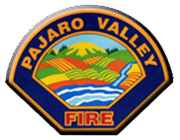Fire Safety
Defensible Space
In January 2005 a new state law became effective that extended the defensible space clearance around homes and structures from 30 feet to 100 feet. Proper clearance to 100 feet dramatically increases the chance of your house surviving a wildfire. This defensible space also provides for firefighter safety when protecting homes during a wildland fire.
Visit The Official CAL FIRE Website for more information on how defensible space can prepare your home for a fire!
Smoke Detectors
- Install a smoke detector on every floor of your home, even the basement.
- Install a smoke detector outside every sleeping area. Ideally, install smoke alarms in every sleeping area, too.
- Test smoke detectors monthly.
- Change the batteries at least once a year-maybe at Daylight Savings Time or on your birthday.
- Teach children what your smoke detectors sounds like and what to do if they hear it-get out and crawl low under smoke.
- Never disable a smoke detector (like for cooking smoke). Consider detectors with hush buttons.
- Never remove a smoke detector battery for some other use, like a radio or video game.
- Keep smoke detector clean. Vacuum them often.
- Replace smoke detector after 10 years.
Carbon Monoxide Detectors
- You can’t see or smell Carbonb Monoxide, but it can kill!
- As of July 1, 2011 the Carbon Monoxide Poisoning Prevention Act (Senate Bill – SB 183 will require all single-family homes with an attached garage or a fossil fuel source to install carbon monoxide detectors within the home by July 1, 2011. Owners of multi-family leased or rental dwellings, such as apartment buildings, have until January 1, 2013 to comply with the law.
- Carbon Monoxide can be deadly!
- You can’t see or smell carbon monoxide, but at high levels it can kill a person in minutes. Carbon monoxide (CO) is produced whenever any fuel such as gas, oil, kerosene, wood, or charcoal is burned. If appliances that burn fuel are maintained and used properly, the amount of CO produced is usually not hazardous. However, if appliances are not working properly or are used incorrectly, dangerous levels of CO can result. Hundreds of people die accidentally every year from CO poisoning caused by malfunctioning or improperly used fuel-burning appliances. Even more die from CO produced by idling cars. Fetuses, infants, elderly people, and people with anemia or with a history of heart or respiratory disease can be especially susceptible. Be safe. Practice the DO’s and DON’Ts of carbon monoxide.
Escape Plans
- Make and practice a fire escape plan.
- Plan for two ways to escape from each room.
- Plan for everyone in your home-including babies and others who need help to escape.
- Pick a place to meet after you escape to check that everyone got out.
- Practice your escape plan every month.
- Practice getting out with your eyes closed, crawling low to the floor.
- Involve children in making and practicing your escape plan.
- Teach children to never hide during a fire-they must get out and stay out.
- Clear toys, boxes, and other debris from exits.
- Check that windows open easily. Fix any that stick.
- Be sure that security bars on doors and windows have a quick-release latch, and everyone knows how to open them.
- Never open a door that feels hot. Escape another way.
- Escape first, then call for help.
Get Out Stay Out!
- In a fire, get out right away. Don’t pause to gather belongings.
- Teach children not to hide, but to get out right away.
- Escape first, then call for help..
- Never go back into a burning home for any reason.
- If someone is missing, tell the firefighters.
Fire Sprinklers in Your Home
Contact Us
Pajaro Valley Fire Station
562 Casserly Rd
Watsonville, CA 95076
Office Tel 831.722.6188
Office Fax 831.722.7333
